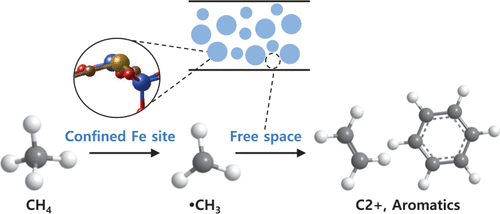当前位置:
X-MOL 学术
›
ACS Catal.
›
论文详情
Our official English website, www.x-mol.net, welcomes your
feedback! (Note: you will need to create a separate account there.)
Nonoxidative Direct Conversion of Methane on Silica-Based Iron Catalysts: Effect of Catalytic Surface
ACS Catalysis ( IF 11.3 ) Pub Date : 2019-07-11 00:00:00 , DOI: 10.1021/acscatal.9b01643
Seung Ju Han 1 , Sung Woo Lee 1 , Hyun Woo Kim 2 , Seok Ki Kim 1, 3 , Yong Tae Kim 1, 3
ACS Catalysis ( IF 11.3 ) Pub Date : 2019-07-11 00:00:00 , DOI: 10.1021/acscatal.9b01643
Seung Ju Han 1 , Sung Woo Lee 1 , Hyun Woo Kim 2 , Seok Ki Kim 1, 3 , Yong Tae Kim 1, 3
Affiliation

|
For a stable methane to olefins, aromatics, and hydrogen (MTOAH) reaction, 0.27–0.43 wt % Fe-containing silica catalysts were synthesized through various preparation methods and tested. The presence of Fe species in SiO2 mixtures increased the true and apparent densities of the catalysts during the melt-fusing process at 1700 °C. Several characterizations (i.e., H2-TPR, TEM, and XAS) revealed that partially reduced iron oxide (Fe3O4) predominantly existed in cristobalite (CRS) in the melt-fused catalysts. The Fe©CRS catalyst prepared from fayalite and quartz by the melt-fusing method showed a higher resistance to structural sintering and coke deposition than other Fe catalysts during MTOAH at 1020 °C. It also showed a 40% higher apparent activation energy for coke formation than for methane consumption in the temperature range of 1000 to 1040 °C. Increased CRS surfaces increased the coke selectivity, indicating that even the pure CRS surface acts as a chain reaction terminator to form coke. At the same space velocity (9400 h–1), the Fe©CRS catalyst was more selective in producing C2 (ethane, ethylene, and acetylene), C3–C5 olefins, and aromatics than pure CRS and other Fe catalysts. At a steady state, the Fe©CRS surface was most suitable for methane conversion, being 2.3 times more efficient than without a catalytic surface. The Fe©CRS catalyst exhibited a stable activity and low coke selectivity, even for 50 h, in the MTOAH reaction. EXAFS profiles showed that highly dispersed Fe carbide with Fe–Si coordination was formed in the Fe©CRS catalyst, and electronic structure calculations indicated that these confined Fe sites were more favorable for methyl radical formation and a high coke resistance than Fe3C clusters. By optimizing reaction parameters, the Fe©CRS catalyst exhibited 6.9–5.8% methane conversion and 86.2% C2 selectivity for 100 h with cofeeding of 50% H2 at 1080 °C.
中文翻译:

二氧化硅基铁催化剂上甲烷的非氧化性直接转化:催化表面的影响
为了使甲烷与烯烃,芳烃和氢气的反应稳定,可通过各种制备方法合成并测试0.27–0.43 wt%的含铁二氧化硅催化剂。SiO 2混合物中Fe的存在增加了催化剂在1700°C熔融熔融过程中的真实密度和表观密度。几种表征(即H 2 -TPR,TEM和XAS)表明,部分还原的氧化铁(Fe 3 O 4)主要存在于熔融熔融催化剂中的方石英(CRS)中。在1020°C的MTOAH期间,由铁橄榄石和石英通过熔融熔融法制得的Fe©CRS催化剂比其他Fe催化剂对结构烧结和焦炭沉积的耐受性更高。在1000至1040°C的温度范围内,其生成的表观活化能也比甲烷消耗的表观活化能高40%。CRS表面的增加会提高焦炭的选择性,这表明即使纯CRS表面也可充当链反应终止剂以形成焦炭。在相同的空速下(9400 h –1),Fe©CRS催化剂在生产C2(乙烷,乙烯和乙炔),C3-C5烯烃和芳族化合物方面比纯CRS和其他Fe催化剂更具选择性。在稳定状态下,Fe©CRS表面最适合甲烷转化,效率是没有催化表面的2.3倍。在MTOAH反应中,Fe©CRS催化剂即使在50小时内也表现出稳定的活性和低的焦炭选择性。EXAFS曲线表明,Fe©CRS催化剂中形成了具有Fe-Si配位的高度分散的Fe碳化物,电子结构计算表明,这些受限的Fe位比Fe 3更有利于甲基自由基的形成和较高的耐焦炭性C集群。通过优化反应参数,Fe©CRS催化剂在1080°C下共进料50%H 2时,在100 h内表现出6.9–5.8%的甲烷转化率和86.2%的C2选择性。
更新日期:2019-07-11
中文翻译:

二氧化硅基铁催化剂上甲烷的非氧化性直接转化:催化表面的影响
为了使甲烷与烯烃,芳烃和氢气的反应稳定,可通过各种制备方法合成并测试0.27–0.43 wt%的含铁二氧化硅催化剂。SiO 2混合物中Fe的存在增加了催化剂在1700°C熔融熔融过程中的真实密度和表观密度。几种表征(即H 2 -TPR,TEM和XAS)表明,部分还原的氧化铁(Fe 3 O 4)主要存在于熔融熔融催化剂中的方石英(CRS)中。在1020°C的MTOAH期间,由铁橄榄石和石英通过熔融熔融法制得的Fe©CRS催化剂比其他Fe催化剂对结构烧结和焦炭沉积的耐受性更高。在1000至1040°C的温度范围内,其生成的表观活化能也比甲烷消耗的表观活化能高40%。CRS表面的增加会提高焦炭的选择性,这表明即使纯CRS表面也可充当链反应终止剂以形成焦炭。在相同的空速下(9400 h –1),Fe©CRS催化剂在生产C2(乙烷,乙烯和乙炔),C3-C5烯烃和芳族化合物方面比纯CRS和其他Fe催化剂更具选择性。在稳定状态下,Fe©CRS表面最适合甲烷转化,效率是没有催化表面的2.3倍。在MTOAH反应中,Fe©CRS催化剂即使在50小时内也表现出稳定的活性和低的焦炭选择性。EXAFS曲线表明,Fe©CRS催化剂中形成了具有Fe-Si配位的高度分散的Fe碳化物,电子结构计算表明,这些受限的Fe位比Fe 3更有利于甲基自由基的形成和较高的耐焦炭性C集群。通过优化反应参数,Fe©CRS催化剂在1080°C下共进料50%H 2时,在100 h内表现出6.9–5.8%的甲烷转化率和86.2%的C2选择性。































 京公网安备 11010802027423号
京公网安备 11010802027423号